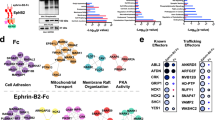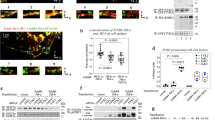Abstract
Eph-related receptors and their ephrin ligands are highly conserved protein families which play important roles in targeting axons and migrating cells. In this study we have examined the functional roles of two major autophosphorylation sites, Tyr-615 and Tyr-838, in the EphA8 receptor. Two-dimensional phosphopeptide mapping analysis demonstrated that Tyr-615 and Tyr-838 constitute major autophosphorylation sites in EphA8. Tyr-615 was phosphorylated to the highest stoichiometry, suggesting that phosphorylation at this site may have a physiologically important role. Upon conservative mutation of Tyr-838 located in the tyrosine kinase domain, the catalytic activity of EphA8 was strikingly reduced both in vitro and in vivo, whereas a mutation at Tyr-615 in the juxtamembrane domain did not impair the tyrosine kinase activity. In vitro binding experiments revealed that phosphorylation at Tyr-615 in EphA8 mediates the preferential binding to Fyn-SH2 domain rather than Src and Ras GTPase-activating protein (Ras GAP)-SH2 domains. Additionally, a high level of EphA8 was detected in Fyn immunoprecipitates in intact cells, indicating that EphA8 and Fyn can physically associate in vivo. In contrast, the association of full-length Fyn to EphA8 containing mutation at either Tyr-615 or Tyr-838 was greatly reduced. These data indicate that phosphorylation of Tyr-615 is critical for determining the association with Fyn whereas the integrity of Tyr-838 phosphorylation is required for efficient phosphorylation at Tyr-615 as well as other major sites. Finally, it was observed that cell attachment responses are attenuated by overexpression of wild type EphA8 receptor but to much less extent by EphA8 mutants lacking phosphorylation at either Tyr-615 or Tyr-838. Furthermore, transient expression of kinase-inactive Fyn in EphA8-overexpressing cells blocked cell attachment responses attenuated by the EphA8 signaling. We therefore propose that Fyn kinase is one of the major downstream targets for the EphA8 signaling pathway leading to a modification of cell adhesion, and that autophosphorylation at Tyr-838 is critical for positively regulating the EphA8 signaling event.
This is a preview of subscription content, access via your institution
Access options
Subscribe to this journal
Receive 50 print issues and online access
$259.00 per year
only $5.18 per issue
Buy this article
- Purchase on Springer Link
- Instant access to full article PDF
Prices may be subject to local taxes which are calculated during checkout






Similar content being viewed by others
References
Bare DJ, Lauder JM, Wilkie MB and Maness PF. . 1993 Oncogene 8: 1429–1436.
Boyle WJ, van der Geer P and Hunter T. . 1991 Methods Enzymol. 201: 110–149.
Brambilla R, Schnapp A, Casagranda F, Labrador JP, Bergemann AD, Flanagan JG, Pasquale EB and Klein R. . 1995 EMBO J. 14: 3116–3126.
Cheng HJ, Nakamoto M, Bergemann AD and Flanagan JG. . 1995 Cell 82: 371–381.
Cooper JA, Esch FS, Taylor SS and Hunter T. . 1984 J. Biol. Chem. 259: 7835–7841.
Davis S, Gale NW, Aldrich TH, Maisonpierre PC, Lhotak V, Pawson T, Goldfarb M and Yancopoulos GD. . 1994 Science 266: 816–819.
Drescher U, Kremoser C, Handwerker C, Loschinger J, Noda M and Bonhoeffer F. . 1995 Cell 82: 359–370.
Ellis C, Kasmi F, Ganju P, Walls E, Panayotou G and Reith AD. . 1996 Oncogene 12: 1727–1736.
Eph Nomenclature Committee. . 1997 Cell 90: 403–404.
Frisen J, Yates PA, McLaughlin T, Friedman GC, O'Leary DD and Barbacid M. . 1998 Neuron 20: 235–243.
Gao PP, Zhang JH, Yokoyama M, Racey B, Dreyfus CF, Black IB and Zhou R. . 1996 Proc. Natl. Acad. Sci. USA 93: 11161–11166.
Gao PP, Yue Y, Zhang JH, Cerretti DP, Levitt P and Zhou R. . 1998 Proc. Natl. Acad. Sci. USA 95: 5329–5334.
Graham FL and van der Eb AJ. . 1973 Virology 54: 536–539.
Grant SG, O'Dell TJ, Karl KA, Stein PL, Soriano P and Kandel ER. . 1992 Science 258: 1903–1910.
Henkemeyer M, Orioli D, Henderson JT, Saxton TM, Roder J, Pawson T and Klein R. . 1996 Cell 86: 35–46.
Hock B, Bohme B, Karn T, Feller S, Rubsamen-Waigmann H and Strebhardt K. . 1998 Oncogene 16: 255–260.
Holland SJ, Gale NW, Gish GD, Roth RA, Songyang Z, Cantley LC, Henkemeyer M, Yancopoulos GD and Pawson T. . 1997 EMBO J. 16: 3877–3888.
Ingraham CA, Cooke MP, Chuang YN, Perimutter RM and Maness PF. . 1992 Oncogene 7: 95–100.
Krull CE, Lansford R, Gale NW, Collazo A, Marcelle C, Yancopoulos GD, Fraser SE and Bronner-Fraser M. . 1997 Curr. Biol. 7: 571–580.
Lackmann M, Oates AC, Dottori M, Smith FM, Do C, Power M, Kravets L and Boyd AW. . 1998 J. Biol. Chem. 273: 20228–20237.
Lhotak V and Pawson T. . 1993 Mol. Cell. Biol. 13: 7071–7079.
Meima L, Kljavin IJ, Moran P, Shih A, Winslow JW and Caras IW. . 1997 Eur. J. Neurosci. 9: 177–188.
Monschau B, Kremoser C, Ohta K, Tanaka H, Kaneko T, Yamada T, Handwerker C, Hornberger MR, Loschinger J, Pasquale EB, Siever DA, Verderame MF, Muller BK, Bonhoeffer F and Drescher U. . 1997 EMBO J. 16: 1258–1267.
Nakamoto M, Cheng HJ, Friedman GC, McLaughlin T, Hansen MJ, Yoon CH, O'Leary DD and Flanagan JG. . 1996 Cell 86: 755–766.
Orioli D, Henkemeyer M, Lemke G, Klein R and Pawson T. . 1996 EMBO J. 15: 6035–6049.
Orioli D and Klein R. . 1997 Trends Genet. 13: 354–359.
Park S and Sanchez MP. . 1997 Oncogene 14: 533–542.
Park S, Frisen J and Barbacid M. . 1997 EMBO J. 16: 3106–3114.
Pandey A, Lazar DF, Salteil AR and Dixit VM. . 1994 J. Biol. Chem. 269: 30154–30157.
Pandey A, Duan H and Dixit VM. . 1995a J. Biol. Chem. 270: 19201–19204.
Pandey A, Shao H, Marks RM, Polverini PJ and Dixit VM. . 1995b Science 268: 567–569.
Schlessinger J. . 1997 Cell 91: 869–872.
Stein E, Cerretti DP and Daniel TO. . 1996 J. Biol. Chem. 271: 23588–23593.
Stein E, Lane AA, Cerretti DP, Schoecklmann HO, Schroff AD, Van Etten RL and Daniel TO. . 1998a Genes Dev. 12: 667–678.
Stein E, Huynh-Do U, Lane AA, Cerretti DP and Daniel TO. . 1998b J. Biol. Chem. 273: 1303–1308.
Twamley-Stein GM, Pepperkok R, Ansorge W and Courtneidge SA. . 1993 Proc. Natl. Acad. Sci. USA 90: 7696–7700.
Umemori H, Sato S, Yagi T, Aizawa S and Yamamoto T. . 1994 Nature 367: 572–576.
van der Geer P, Hunter T and Lindberg RA. . 1994 Annu. Rev. Cell Biol. 10: 251–337.
Wang HU and Anderson DJ. . 1997 Neuron 18: 383–396.
Wang HU, Chen ZF and Anderson DJ. . 1998 Cell 93: 741–753.
Winning RS, Scales JB and Sargent TD. . 1996 Dev. Biol. 179: 309–319.
Yagi T, Shigetani Y, Okado N, Tokunaga T, Ikawa Y and Aizawa S. . 1993a Oncogene 8: 3343–3351.
Yagi T, Aizawa S, Tokunaga T, Shigetani Y, Takeda N and Ikawa Y. . 1993b Nature 366: 742–745.
Yagi T, Shigetani Y, Furuta Y, Nada S, Okado N, Ikawa Y and Aizawa S. . 1994 Oncogene 9: 2433–2440.
Zisch AH, Kalo MS, Chong LD and Pasquale EB. . 1998 Oncogene 16: 2657–2670.
Acknowledgements
We are indebted to Dr Jonas Frisen and Diana Clarke for their valuable discussions, Jaemin Jeong for his excellent technical assistance, and Dr Dongeun Park for human Fyn plasmids. The authors wish to acknowledge the financial support of the Korea Research Foundation made in the Program Year 1997. This research was also supported by the Hallym Academy of Sciences, Hallym University, Korea.
Author information
Authors and Affiliations
Rights and permissions
About this article
Cite this article
Choi, S., Park, S. Phosphorylation at Tyr-838 in the kinase domain of EphA8 modulates Fyn binding to the Tyr-615 site by enhancing tyrosine kinase activity. Oncogene 18, 5413–5422 (1999). https://doi.org/10.1038/sj.onc.1202917
Received:
Revised:
Accepted:
Published:
Issue Date:
DOI: https://doi.org/10.1038/sj.onc.1202917
Keywords
This article is cited by
-
Endocytosis of EphA receptors is essential for the proper development of the retinocollicular topographic map
The EMBO Journal (2011)
-
EphA8-ephrinA5 signaling and clathrin-mediated endocytosis is regulated by Tiam-1, a Rac-specific guanine nucleotide exchange factor
Molecules and Cells (2010)
-
The EphA8 receptor induces sustained MAP kinase activation to promote neurite outgrowth in neuronal cells
Oncogene (2005)
-
Multiple roles of eph receptors and ephrins in neural development
Nature Reviews Neuroscience (2001)



